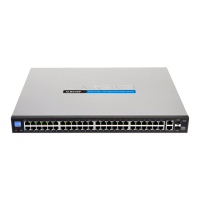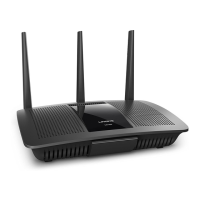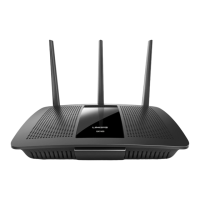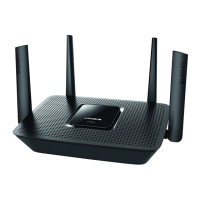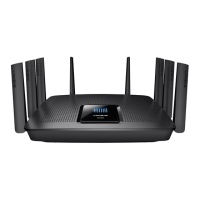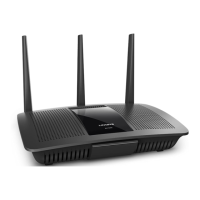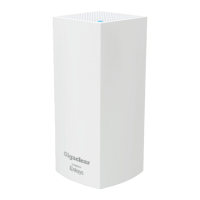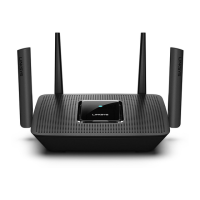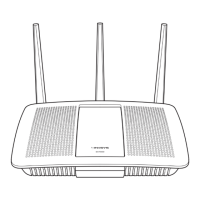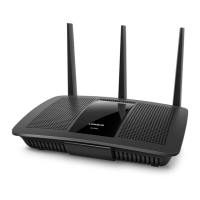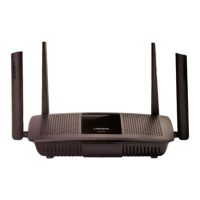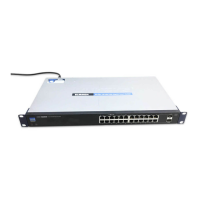
Do you have a question about the Linksys SLM2024 and is the answer not in the manual?
| Brand | Linksys |
|---|---|
| Model | SLM2024 |
| Category | Network Router |
| Language | English |
Explains icons used in the user guide for attention.
Lists useful website addresses for further information.
Provides legal information regarding product branding and ownership.
Provides an overview of the Linksys Business Series Smart Gigabit Ethernet Switch features.
Details the front and back panel features and ports of the SLM2048 model.
Details the front and back panel features and ports of the SLM2024 model.
Details the front and back panel features and ports of the SLM248G model.
Details the front and back panel features and ports of the SLM248P model.
Details the front and back panel features and ports of the SLM224G model.
Details the front and back panel features and ports of the SLM224P model.
Explains how to connect network devices to the switch.
Discusses important factors and guidelines before installing the switch.
Provides instructions for placing the switch on a desktop surface.
Offers guidelines and steps for mounting the switch in a standard rack.
Details the physical steps for connecting network devices to the switch ports.
Explains how to connect the switch to a higher-level network segment.
Introduces the main configuration interface and basic system information.
Displays a summary of switch information and current port status.
Allows configuration of system name, location, contact, and IP address settings.
Configures the switch's system date, time, time zone, and daylight saving settings.
Provides access to configure port settings, link aggregation, and PoE power.
Displays and allows configuration of individual port speed, duplex, and flow control.
Enables creation of aggregated links (LAGs) for increased bandwidth and redundancy.
Configures Link Aggregation Control Protocol (LACP) for automatic LAG negotiation.
Allows configuration and management of Power over Ethernet (PoE) for specific ports.
Manages Virtual Local Area Networks (VLANs) for network segmentation and isolation.
Allows creation and configuration of global parameters for new VLANs.
Configures VLAN behavior for specific ports, including frame types and PVID.
Assigns ports to VLANs and specifies whether they are tagged or untagged.
Displays VLAN membership information for each port and allows modification.
Provides access to display statistical information for network interfaces.
Shows detailed packet statistics for Ethernet ports or LAGs.
Manages security features including 802.1X, port security, and access control.
Configures port-based 802.1X authentication using an external server.
Secures individual ports by limiting access based on MAC addresses.
Specifies IP addresses that are permitted to manage the device.
Configures broadcast and multicast storm control to limit network flooding.
Configures RADIUS servers for centralized user authentication and authorization.
Manages Quality of Service (QoS) settings for traffic prioritization and bandwidth management.
Configures Class of Service (CoS) settings for traffic prioritization based on Layer 2 priority.
Defines QoS queue forwarding types and mapping for traffic prioritization.
Maps Differentiated Services Code Point (DSCP) values to specific queues for QoS.
Configures basic QoS mode and trust settings for traffic handling.
Manages Spanning Tree Protocol (STP) to prevent network loops and ensure loop-free topology.
Displays the current Spanning Tree Protocol (STP) status of the switch.
Configures global STP parameters, including BPDU handling and path cost defaults.
Assigns specific STP settings to individual network interfaces like ports or LAGs.
Manages multicast configuration options, including IGMP snooping and bridge multicast settings.
Configures IGMP snooping globally and for specific VLANs to optimize multicast traffic.
Manages bridge multicast settings for ports and LAGs, assigning them to multicast groups.
Configures the forwarding of multicast packets to appropriate ports or VLANs.
Provides access to system administration settings, tools, and user management.
Manages user accounts, passwords, and authentication methods for device access.
Assigns static IP addresses to specific network interfaces for consistent access.
Manages dynamic MAC addresses learned by the switch and their aging parameters.
Configures port mirroring for traffic monitoring, analysis, and debugging purposes.
Allows uploading and downloading switch configuration files via TFTP or HTTP.
Downloads firmware upgrade files from a TFTP server or a computer.
Restarts the switch, automatically saving current configuration settings.
Resets the switch to its original factory default settings, erasing current configuration.
Manages system logs, enabling logging and setting event message levels.
Displays system logs that are saved in RAM (Cache) in chronological order.
Displays system logs saved in flash memory, including severity and message text.
Terminates the current login session and logs out of the web interface.
Explains Gigabit Ethernet speed, integration, and hardware requirements.
Describes fiber optic cabling types, connectors, and their use in networks.
Provides definitions of basic networking terms encountered in the manual.
Lists detailed technical specifications for SLM2024 and SLM2048 switch models.
Lists detailed technical specifications for SLM224G, SLM248G, SLM224P, SLM248P models.
Details the limited warranty terms, conditions, and customer responsibilities for Linksys products.
States the equipment's compliance with FCC rules for Class A digital devices.
Provides important safety precautions and warnings for product usage and handling.
States the equipment's compliance with Canadian ICES-003 standards.
Lists contact details for Linksys customer support, RMA, and other services.
